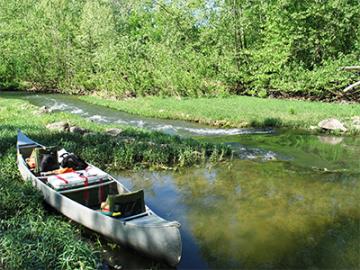Division of Environmental Quality Director: Art Goodin



What is Natural Resource Damage Assessment and Restoration (NRDAR)?
The core philosophy of natural resource damage assessment and restoration is a state’s public lands, waters, geologic and living resources are held in “trust” for the benefit of the citizens of the state. Citizens have the right to use and enjoy natural resources. State and federal trustee agencies work in cooperation to manage natural resources. The trustees have the duty and responsibility to protect these resources on behalf of the public.
When a hazardous substance or pollutant release occurs, the trustees work to restore, rehabilitate, replace or acquire natural resources equal to those injured by the release. The trustees are tasked with determining the type and extent of injuries to the natural resources and restoring the injured natural resources for the benefit of the public when possible.
Who is Involved in Natural Resource Damage Assessment and Restoration?
The State of Missouri has trusteeship for all natural resources contained within its boundary. The governor designated the director of the Missouri Department of Natural Resources as the state natural resource trustee. The department may act alone under state or federal authorities such as the Comprehensive Environmental Response, Compensation, and Liability Act (CERCLA), commonly known as Superfund.
The department also shares trusteeship over certain federal “Trust Resources,” such as migratory birds, endangered species and the habitats connected with those resources. In 2004, the Missouri Natural Resource Trustee Council was established through an agreement between the department (state trustee) and the U.S. Fish and Wildlife Service (federal trustee). The U.S. Forest Service is also a federal trustee for certain sites on forest service property in the Viburnum Trend Lead Mining District. The department may work with the federal trustees and those responsible for damaging the natural resources to conduct restoration projects.
How does the department approach environmental impacts and restoration?
Where possible, the natural resource trustees and parties responsible for the damages work together through a cooperative assessment process. The assessment is used to determine the extent of the impacts and suitable restoration projects for the responsible party to perform as compensation for the injured resources. The natural resource trustees may also negotiate with those responsible to recover the costs of restoring the natural resources, the cost of the lost use of the resources and the cost incurred by the natural resource trustees to assess the injuries. If a settlement cannot be reached, the natural resource trustees may decide to conduct a formal Natural Resource Damage Assessment and proceed with litigation.
For information about the resources used to conduct these assessments and information about current assessment studies, visit the department's NRDAR References webpage.
How is Natural Resource Damage Assessment and Restoration different from Superfund Remediation?
Natural Resource Damage Assessment and Restorations are often performed at sites also undergoing Superfund remedial actions by the U.S. Environmental Protection Agency. The two processes are both authorized by CERCLA, have a similar overall structure and are sometimes performed at the same time. They often use the same data and information sources; however, they use different models and methodologies to address different aspects of hazardous substance releases. They are designed to work together, but their goals are different.
Natural Resource Damage Assessment and Restorations focus on returning injured natural resources, including habitat and species, to their pre-release state. It also addresses the loss of ecosystem services over time due to hazardous substance releases. A natural resource trustee may use soil contaminant data and plant or animal tissue data in the Habitat Equivalency Analysis or Resource Equivalency Analysis model to develop estimates of the level of natural resource habitat or organisms necessary to replace the ecosystem services lost through injury from hazardous substance contamination.
The goal of remedial actions is to eliminate unacceptable risks to human health and the environment due to any hazardous substance release or threatened release. Remediation is cleaning up the contaminated media (soil, sediment or water) that may affect local plant or animal populations' ability to recover and maintain themselves in a healthy state. Remedial actions do not consider the resources lost over time from the release nor are they designed to restore resources to pre-release conditions.
What restoration projects are currently underway?
Public notices about the availability of information and the opportunity for public comment are announced on the department's What's New in NRDAR webpage, as well as on the U.S. Fish & Wildlife Service’s Natural Resource Damage Assessment and Restoration webpage.
For information about specific restoration projects:
Nothing in this document may be used to implement any enforcement action or levy any penalty unless promulgated by rule under chapter 536 or authorized by statute.
For more information
Natural Resource Damage Assessment and Restoration
Environmental Remediation Program
P.O. Box 176
Jefferson City, MO 65102-0176
United States
